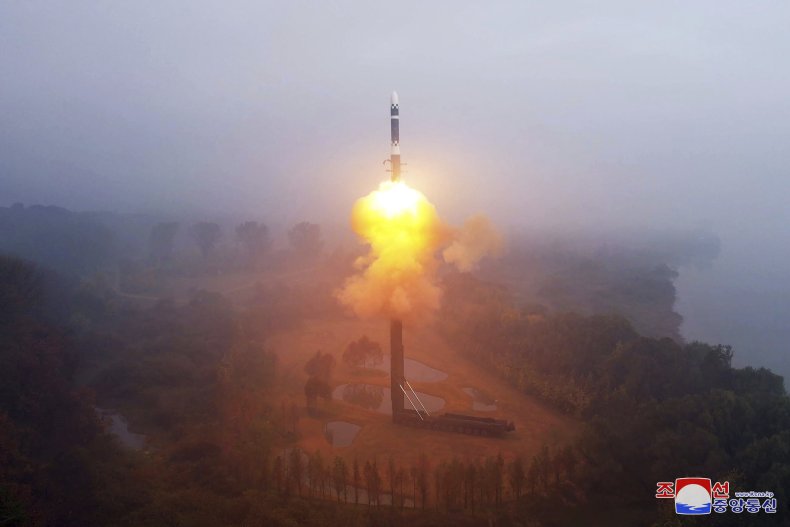North Korea on Friday released footage showing the test launch of its newest and largest intercontinental ballistic missile (ICBM), which has the ability to attack mainland United States.
State media in North Korea claimed the nuclear-capable ICBM, officially known as the Hwasong-19, is "an ICBM of ultimate version" and the most powerful strategic missile in the world. Its test-fire was approved and observed by the country's leader, Kim Jong Un.
A military official in South Korea said the new missile was fired from a transporter erector launcher, which has 11 axles and a length of 98 feet. It is longer than the previously known largest ICBM of the North, the Hwasong-17, which has 11 axles but is about 75 feet long.
The missile was launched on Thursday from an undisclosed location in North Korea. It flew a distance of 622 miles and reached a maximum altitude of 4,776 miles before landing on a target area in the open waters of the East Sea, also known as the Sea of Japan.
While the missile traveled on a steep vertical path to avoid the sovereign airspace of other countries, Japan estimated the Hwasong-19 is capable of flying over 9,320 miles, which could deliver a nuclear strike to the continental U.S. if it fired on a normal trajectory.
From Pyongyang, it is 6,800 miles to Washington, D.C., and New York, 5,600 miles to San Francisco, and 5,100 miles to Seattle. The Hwasong-19 can strike the East and West Coasts of the U.S. from anywhere in the Korean Peninsula.
Photos published by North Korean state media show the nose cone of the new missile to be more rounded than its predecessor, the Hwasong-18, another ICBM of the North using solid-fuel technology. This indicated it would carry more than one nuclear warhead.

In Focus
North Korea Launches Hwasong-19 ICBM
This photo provided by the North Korean government shows what it says is a test launch of new intercontinental ballistic missile Hwasong-19 at an undisclosed place in North Korea on October 31. It is estimated the missile is capable of striking the continental United States.
Launch Slideshow 3 PHOTOS
North Korea did not reveal on Friday whether it has developed a long-range missile using a multiple independently targetable reentry vehicle, which is a payload allowing several warheads to be carried by a single missile and to strike different targets on the ground.
In June, North Korea claimed that it had verified a delivery system that could overwhelm air defense systems by releasing multiple warheads per one missile. However, the South Korean military said the North's test of the game-changing weaponry failed.
The U.S. has deployed 44 interceptor missiles in Alaska and California to defend against the North Korean ICBM threat. The stated shot doctrine for the Ground-based Midcourse Defense system is four to five interceptors per incoming ICBM.
North Korea is one of the nine countries armed with nuclear weapons. The Stockholm International Peace Research Institute (SIPRI) estimated that the country has around 50 nuclear warheads with sufficient fissile material to reach a total of up to 90 warheads.
Prior to the test launch on Thursday, North Korea had publicized five types of ICBM, which also included the Hwasong-13, -14, and -15. However, their deployment status is currently unknown, with Hwasong-15, -17, and -18 probably operational, SIPRI said.




















 English (US) ·
English (US) ·